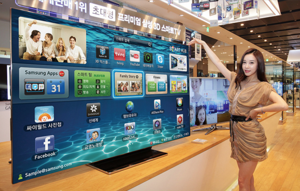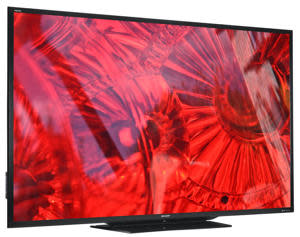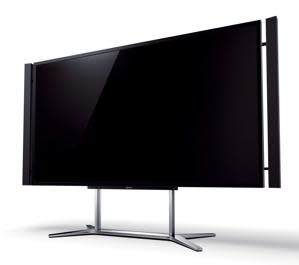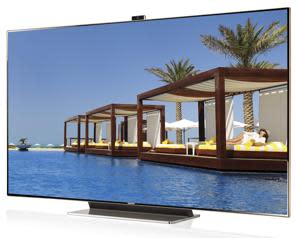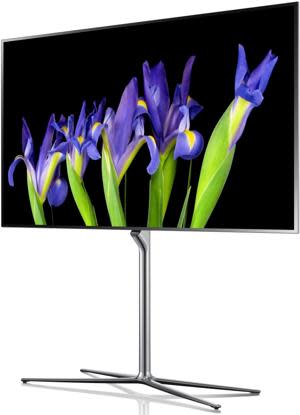Dream TVs: If price were no object

If you have a few bucks and an affinity for TV shows, movies or video games, you might want to clear out some space in your media room.
Televisions aren't just getting bigger — er, much bigger -- but also more stunning, thinner and smarter.
From the latest supersized LED-backlit TVs and razor-thin OLED (Organic Light-Emitting Diode) televisions to "ultra-definition" television with four times the resolution of an HDTV and glasses-free 3D, there might be fewer reasons to leave your La-Z-Boy in the months and years to come.
Whether you have unlimited funds or just want to dream big, the following is a look at a few new televisions and a handful of models around the corner.
Bigger screens
If you don't mind a TV the size of a garage door, Sharp's 90-inch LED TV (model # LC-90LE745U; $9,999.99) has all the bells and whistles you'd expect: a 1080p panel with 120Hz frame doubling for smoother motion; full-array LED backlighting for rich colors and high contrast (5000:1 contrast ratio); Full HD active 3D technology; and built-in Wi-Fi, apps and Skype.
Oddly, for a nearly five-figure TV you have to buy the Skype camera separately and you only get two pair of 3D glasses. Also be aware this massive television lacks Sharp's much-hyped Quattron technology, which adds a yellow pixel to each red, green, and blue picture element.
While it's not a flat-panel television, Mitsubishi has a 92-inch 3D 1080p HDTV (model # WD-92840) that can be found as low as $2,700 from various online retailers. The huge 25-inch-deep television employs digital light processing (DLP) projection technology and includes an audio bar for better-quality sound.
Greater detail
Sony recently took the wraps off the 84-inch XBR-84X900 ($24.999.99), the company's first 4K TV that rocks 3,840 x 2,160 resolution, or more than eight million individual pixels. Compare this to 1080p HDTVs that offer up to 1,920 by 1,080 resolution, or more than 2 million pixels.
Naturally, you'll need a 4K source to see all that information, but Sony says this television can also up-convert existing content, such as movies and TV shows. Available before the holidays, this big-screen beauty will also house ten separate built-in speakers to create a virtual 5.1 surround sound setup.
Other features include LED backlighting, a 3-chip 4K X-Reality Pro picture engine, passive 3D HD support and wired/wireless network connectivity and services.
LG Electronics is also launching an 84-inch 4K TV by November, priced at $19,999.
At the 2012 Consumer Electronics Show (CES), Sharp upped the ante by unveiling a prototype 8K TV, doubling the resolution once again. The 85-inch television displayed content recorded on an 8K camera -- at an unprecedented resolution of 7,680 x 4,320.
Style, smarts
Now available for $8,999, Samsung's new Series 9 Smart LED TV (ES9000 LED TV) has a 75-inch frameless monolithic screen, integrated pop-out camera for video calling, super-slim 0.31-inch curved "floating" bezel with no visible seams, and a rose gold finish.
This flagship television also includes Samsung's Smart TV platform -- now with more than 400 downloadable apps — and support for All Share to stream audio, video and photos from other nearby devices (over Wi-Fi).
Other top-of-the-line specs of the ES9000 include 240Hz frame quadrupling, active 3D playback and upconversion, and multiple ports: 3 HDMI, 3 USB, Ethernet, component and composite.
Tall, thin and dark
Instead of using liquid crystals or plasma, OLED (pronounced "oh-led") TVs contain several layers of stacked "organic" (mainly carbon) materials that operate on the attraction between positively and negatively charged particles; when electricity is applied, luminescent light is emitted to produce the image and therefore no backlighting is required.
OLED televisions, like Samsung's upcoming 55-inch ES9500 (no price or date has been announced) are ridiculously thin at just four millimeters thick, plus they boast unprecedented contrast ratios (near perfect blacks), rich colors and fast response times to eliminate motion blur.
And thanks to the TV's high processing speed, Samsung says two people can watch two different shows at the same time on the same full screen, via the 3D glasses with built-in wireless headphones.
Glasses free 3D
What's that? 3D in the home was over before it began? Well, what if you didn't have to wear glasses to see the effect and there was a lot more content to justify the investment?
Glasses-free 3DTV is on its way -- from companies like Sony, Toshiba and LG — but don't hold your breath on a release date.
Sony's 46-inch prototype at the 2102 CES show was the most impressive; not only did objects appear to come out of the screen, such as fish swimming in an ocean, but you didn't have to stand right in the center of the room for the effect to work. Being limited to a "sweet spot" is one of the major downsides to glasses-free 3D displays. Still not quite ready for primetime, but glasses-free 3D might be coming soon to a family room near you.
Check out more tech trends and news at Digital Crave.
